The 7 Best PC Cases For Airflow To Boost Thermal Performance
Choosing the best airflow PC case for your next build should be your top priority. Airflow is a surprisingly undervalued factor and many new PC builders do not pick out the best cases for airflow.
Nowadays, the PC case market is filled with dozens of case options that have very poor airflow. Case manufacturers tend to prioritize aesthetic choices like tempered glass and RGB lighting over actual airflow.
Poor airflow can lead to higher temperatures of components such as your CPU and GPU, making them perform worse and shortening their lifespans. This is why it is always wise to look for cases that have the best airflow configurations.
You can also check out our selection of the best water cooling cases if you are going down that route. Without further ado, here are our picks for the very best airflow PC cases on the market.
The Best Airflow PC Case – Our Picks
| # | Preview | Product Name | Award | Details |
|---|---|---|---|---|
| 1 | 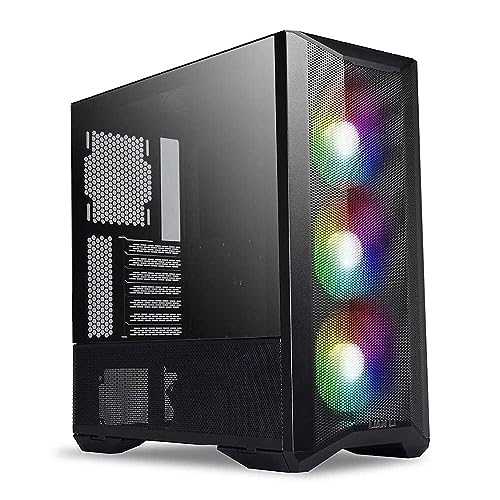 | Lian Li LANCOOL II Mesh | Best Overall Airflow PC Case | Check Price |
| 2 |  | Fractal Design Torrent RGB | Best Premium Airflow PC Case | Check Price |
| 3 | 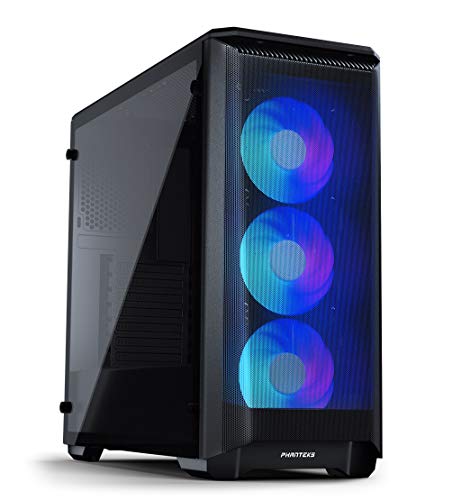 | Phanteks Eclipse P400A | Best Looking Airflow PC Case | Check Price |
| 4 |  | Fractal Design Meshify C | Best Built Airflow PC Case | Check Price |
| 5 | 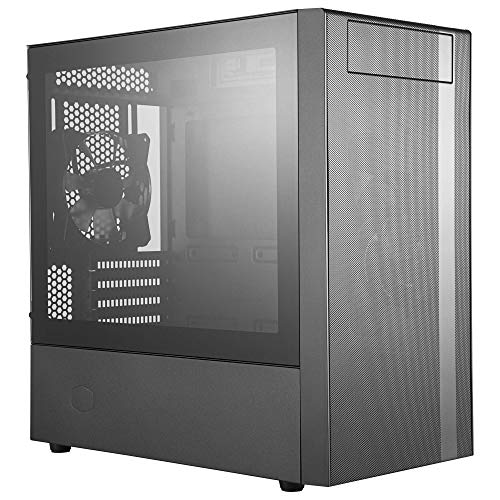 | CoolerMaster NR600 | Best Micro ATX Airflow PC Case | Check Price |
| 6 |  | Fractal Design Focus G | Best Value Airflow PC Case | Check Price |
| 7 |  | CoolerMaster MasterBox Q500L | Best Budget Airflow PC Case | Check Price |
| # | 1 |
| Preview |  |
| Product Name | Lian Li LANCOOL II Mesh |
| Award | Best Overall Airflow PC Case |
| Details | Check Price |
| # | 2 |
| Preview |  |
| Product Name | Fractal Design Torrent RGB |
| Award | Best Premium Airflow PC Case |
| Details | Check Price |
| # | 3 |
| Preview |  |
| Product Name | Phanteks Eclipse P400A |
| Award | Best Looking Airflow PC Case |
| Details | Check Price |
| # | 4 |
| Preview |  |
| Product Name | Fractal Design Meshify C |
| Award | Best Built Airflow PC Case |
| Details | Check Price |
| # | 5 |
| Preview |  |
| Product Name | CoolerMaster NR600 |
| Award | Best Micro ATX Airflow PC Case |
| Details | Check Price |
| # | 6 |
| Preview |  |
| Product Name | Fractal Design Focus G |
| Award | Best Value Airflow PC Case |
| Details | Check Price |
| # | 7 |
| Preview |  |
| Product Name | CoolerMaster MasterBox Q500L |
| Award | Best Budget Airflow PC Case |
| Details | Check Price |
Last Update on 2025-07-05 at 11:33 / Affiliate links / Images from Amazon Product Advertising API
1. Lian Li LANCOOL II Mesh
Best Overall Airflow PC Case
Form Factor: Mid-Tower | Front Material: Mesh Panel | Side Material: Tempered Glass | Included Fans: 3x 120mm RGB Fans | Motherboard Support: E-ATX, ATX, Micro-ATX, mini-ITX
Lian Li is a popular name in the computer hardware industry, producing anything from desktop computer cases to power supplies, cooling options, and even workstations. After the relative failure of their Lancool II series, they released the Lancool II Mesh line, which prioritizes airflow above other elements to keep your system cool. These models are also available in white, at a slightly higher cost than black.
The white version of the Lian Li LANCOOL II Mesh can also be considered one of the best white PC cases on the market.
Rather than force consumers to choose between two different models of the Lancool II Mesh, Lian Li has released two models at the same price, the Lancool II Mesh Performance and the Lancool II Mesh RGB, both of which are identical in every way except for their color scheme. The difference between these variations would seem obvious at first glance; one supports RGB fans, while the other is more minimalist.
A complete mesh front panel with huge 1.5 mm holes is featured on both the RGB and performance models. Mesh panels on the inside of the casing allow for maximum airflow, resulting in system cooling that is unmatched by prior models. This Mesh pattern was chosen because it is both aesthetically pleasing and functional since it helps to filter the air that is drawn in.

A USB type-C port is located on the top of the casing, along with two USB 3.0 ports, a power reset switch, a combined mic and audio jack, and a reset button. In addition to the standard reset button, the performance model includes a built-in fan controller with Low, Medium, High, and Auto configuration choices. The RGB version also has a reset button and an A-RGB Color and Mode button.
Your storage drives are easily accessible via the drive cage’s tidy cutouts on the back end, which allow for access to the drives’ power and data connections. To provide more room for the PSU cables, this cage is mounted on a sliding panel that allows it to travel back and forward.
In this regard, two 120 mm fans may be installed below the basement’s detachable cover panels to help in cooling your GPU. Lian Li preinstalled three regular PWM 120 mm fans and a detachable fan controller on the motherboard’s rear that can handle up to 6 four-pin fans.
An innovative rotating motherboard panel is built into the motherboard tray, allowing the user to install a motherboard up to 280mm wide, which is the maximum size for an E-ATX form factor. There are two huge panels installed behind the motherboard to conceal all the messy wires. Aside from the SSDs, nothing except the tempered glass and the matte black covers are visible.
Due to the mesh construction, air can circulate freely within, making it much cooler than you’d anticipate. Additional mesh panels at the system’s rear increase its cooling capacity further. We advise going with the Performance variant since it offers the best airflow solution while also remaining fairly simple in design.
In essence, this PC case won us over with its clean design, convenient cable management features, solid build, and excellent ventilation. Thanks to its many innovative features and excellent thermals, we recommend this case as the best overall airflow PC case in our roundup.
2. Fractal Design Torrent RGB
Best Premium Airflow PC Case
Pros
- Unique Front Panel
- Designed for Airflow
- Neat Cable Management
- Comes with 5 RGB Fans
Cons
- Quite Expensive
Form Factor: Full Tower | Front Material: Plastic Vents | Side Material: Tempered Glass | Included Fans: 2x 180mm RGB fans, 3x 140mm RGB fans | Motherboard Support: E-ATX, ATX, Micro-ATX, mini-ITX
Fractal is a company known for producing high-quality products that are both aesthetically pleasing and functionally robust. Fractal has introduced the Torrent series which is intended solely to deliver optimal airflow. The Torrent is available in three different form factors: the Compact for mid-tower setups, the Nano for mini-ITX motherboards, and the conventional Torrent for full-tower setups.
Maximum ventilation has been built into this enclosure as the name seems to suggest. It does so by including two fans and a silver Y-shaped grill on the front panel. As we are well aware of Fractal’s tendency to prioritize airflow, the Prisma AL-18 180 mm fans were provided rather than the more common 120 mm or 140 mm fans. It may not seem like much, but these fans spin at nearly 1200 RPM. Keep in mind that despite its slower rotational speed, this 180mm fan provides significantly higher airflow.
There is a dust filter below the front grill panel and another one at the bottom of the casing that can be pulled out to the front. The three Fractal-supplied Prisma AL-14 PWM 140 mm fans in the bottom row are protected by this dust filter.
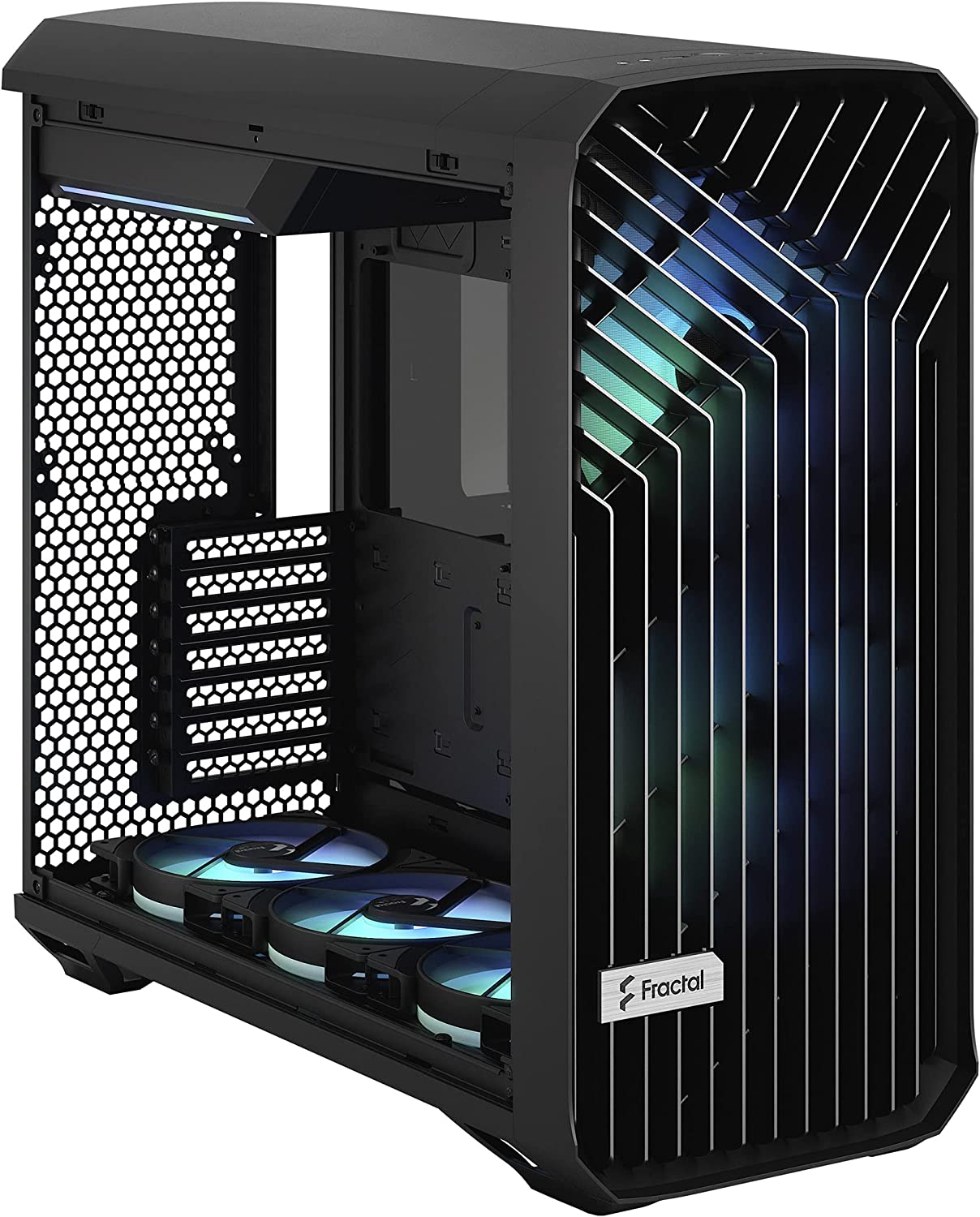
The IO ports are located on the top panel, but the design is kept simple by keeping the power button centrally located and the two USB 3.0 ports on the sides. The headphone and microphone jack are located on the left, while the USB type-C port and the reset button are on the right. Each of the four SSD trays is secured to the chassis by a single metal screw. The rear of the motherboard tray has two more 3.5-inch expansion slots.
We get tempered glass on the case’s sides, and in this iteration, the glass is black with a subtle tint. The glass may be easily removed by pulling it out of its slots from the top. While this may make removing the panel less of a hassle, it also makes it less secure. The same tempered glass is found on the other side of the case, and there are plenty of Velcro straps and rubber grommets inside to keep cables neat and tidy.
The Fractal Design Torrent RGB Black’s whole rear panel has a cutout in a honeycomb design, allowing for optimal heat dissipation, whereas other cases just provide a small gap cutout for the fan to exhaust the heat out of the system.
Considering the negatives, though the silver grille up front seems sturdy, it is really comprised of lightweight plastic. Given the high price of this computer case, this is a minor letdown. There’s a chance it’ll break easily because it’s made of plastic.
You can also check out our list of the best open-air cases for more options in that category.
With its bigger 180 mm fans, the Fractal Design Torrent RGB Black aims to be the most effective airflow PC case possible. The design is the tiebreaker, and it shows that Fractal has produced this device without cutting back on quality.
Although not perfect, this case easily earns the title of best premium airflow PC case due to its plentiful positives and minimal negatives in terms of features, design, and performance.
3. Phanteks Eclipse P400A
Best Looking Airflow PC Case
Pros
- Spacious Interior
- Front Mesh Panel
- Good Quality Included Fans
- Lots of Expansion Options
Cons
- RGB version can be pricy
Form Factor: Mid-Tower | Front Material: Mesh Panel | Side Material: Tempered Glass | Included Fans: 2x 120mm Black Fans | Motherboard Support: ATX, Micro-ATX, mini-ITX
Phanteks is widely regarded as one of the finest and most popular case makers in the industry, and the company’s Eclipse line of cases has quickly emerged as a crowd favorite among PC builders. The goal of the series is to offer a premium product at a price that is affordable.
This product will provide all of the necessary elements for a fantastic case, but it will not have any extra “bells and whistles” that are just not necessary. This pattern continues with the Phanteks Eclipse P400A, which is among the very best cases with impressive airflow and is a continuation of the trend.
The RGB lighting in this case is very well-implemented and is one of the best PC case lighting solutions we have yet seen.
The Phanteks Eclipse P400A is a mid-tower chassis that has the fantastic build quality and a wide variety of incredible features. The front of the case is composed of mesh, which allows for improved ventilation, while the left side of the enclosure contains a side panel made of tempered glass.
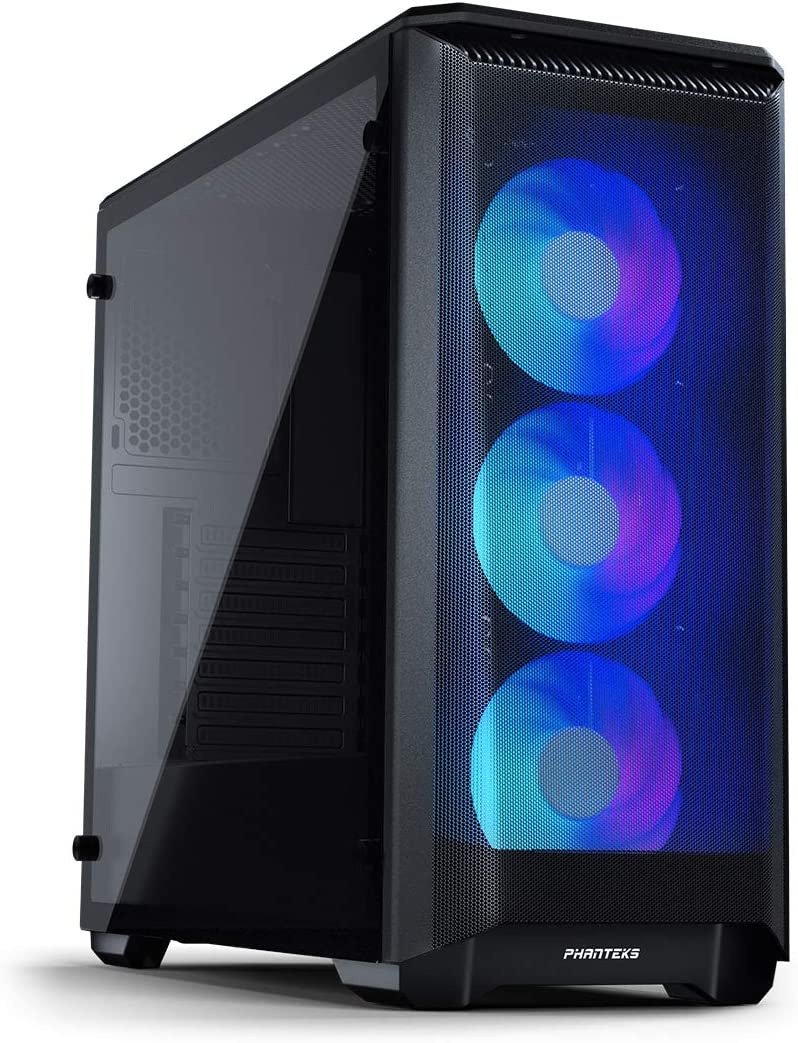
Since the chassis is compatible with ATX, micro ATX, and mini-ITX motherboards, you have the flexibility to configure the P400A according to your preferences. In addition, Phanteks has improved the value proposition for this case by including two black 120mm fans in the package at no additional cost to the customer.
There is an RGB version of the Phanteks P400A that costs a bit more but comes with 3 front RGB fans in the case. This can improve the airflow even more along with looks, making the P400A the best looking airflow PC case.
The cabin of the P400A is relatively roomy inside, providing plenty of working space for its occupants. The front of the case is designed to accommodate either a 240mm or a 360mm radiator, and there are additional radiator mounting locations available for a 280mm radiator as well. Even our selection of the best CPU coolers for i9 13900K tops out at 360mm.
You also have the option of installing a 240mm radiator on the top of the P400A, and the rear panel can accommodate a 120mm radiator.
In terms of the alternatives available for installing the radiator, this translates to the P400A having a high degree of versatility. In addition, the chassis is designed to accommodate a wide variety of storage devices, including up to six hard disc drives (HDDs) and eight solid-state drives (SSDs) measuring 2.5 inches across. The initial kit comes with both two HDD trays and two SSD mounts that are specifically designed for use with SSDs.
Rubber grommets cover the cutouts in the steel panel, making the case an excellent choice for cable management. In addition, the panel is made of steel. It is evident that the presence of these grommets, which are not even present in some $100 cases, is a fantastic addition here.
Since the rear area behind the motherboard tray is also fairly adequate for cable management, you should not have too much of an issue when it comes to handling your custom-sleeved wires in this case. In order to make the front I/O as user-friendly as possible, it has two USB 3.0 ports, a microphone, headphones, a power button, a reset switch, and a controller for three different fan speeds.
When considering its reasonable, the Phanteks P400A offers a level of value that is nearly impossible to match. If you are hunting for a value-oriented PC case with supreme airflow, you can confidently recommend this one thanks to the front mesh panel as well as the comprehensive support for water cooling radiators and storage drives.
4. Fractal Design Meshify C
Best Built Airflow PC Case
Form Factor: Mid-Tower | Front Material: Mesh Panel | Side Material: Tempered Glass | Included Fans: 2x 120mm Black Fans | Motherboard Support: ATX, Micro-ATX, mini-ITX
Some cases tend to be more suited to one function than another, as is the case with “gaming” cases that focus on aesthetics at the expense of adequate ventilation. This is not the case with Fractal Design Meshify C, however, which is a case with a great airflow design and aesthetics that can give any other case a run for its money.
Aside from its all-black color scheme, the Fractal Design Meshify C doesn’t offer much in the way of novelty. The all-black aesthetic makes it suitable for use in a wide variety of gaming environments. However, white cases are becoming more popular, so if that’s what you’re seeking, you might want to take a look at our roundup of the best white PC cases.
The Meshify C from Fractal Design is a small and stylish case that doesn’t skimp on durability. Modern devices typically have a tempered glass surface on one side, but if you want a more conventional look, a version with a solid panel is also available. Airflow is increased and maintenance is simplified thanks to the front filter’s angular mesh.
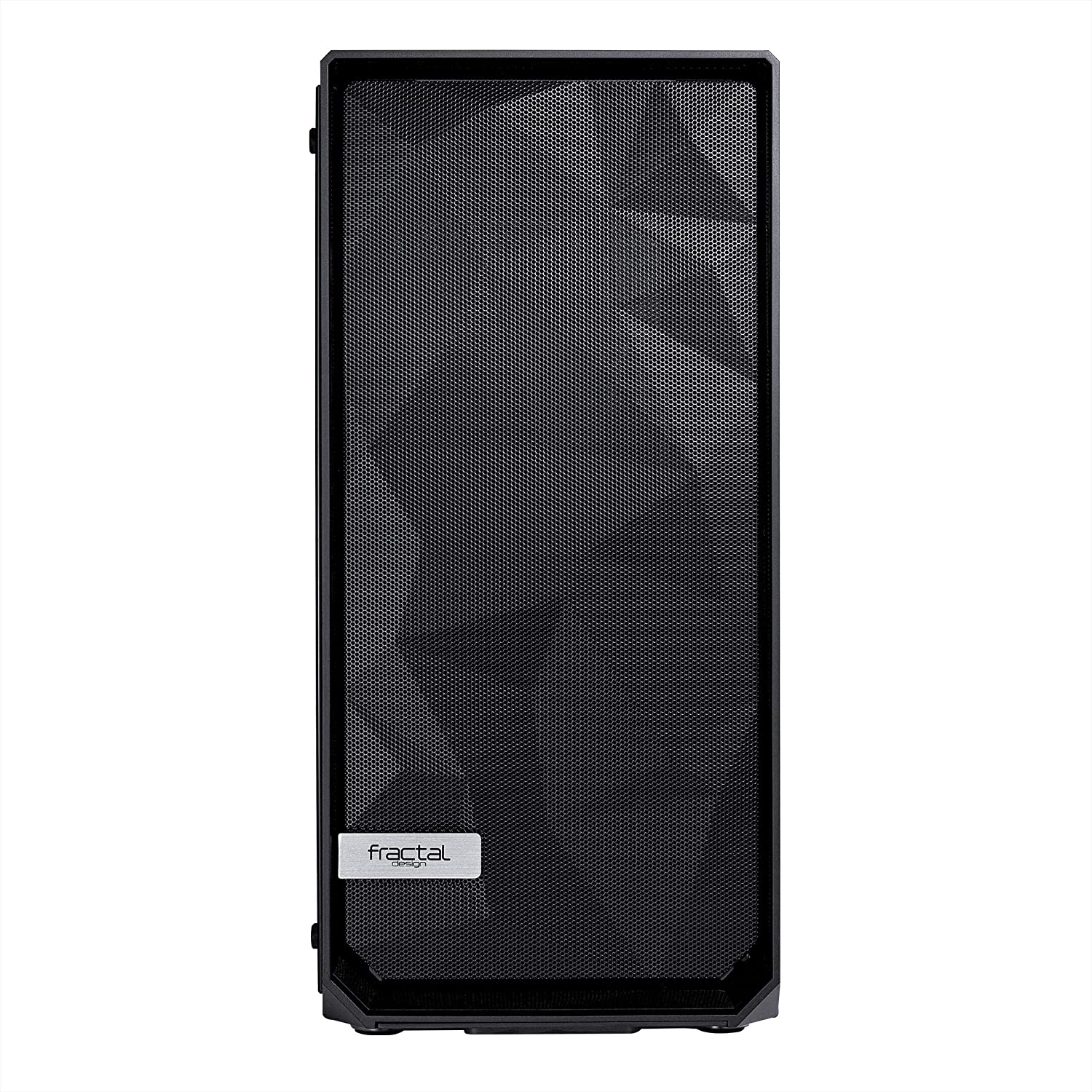
Two 120mm fans are already integrated into the Fractal Design Meshify C, providing even more effective cooling. The provided fans are very silent and move a lot of air, which is exactly what we want to see in a case like this. There is no RGB option, but you can swap out the fans if you purchase one of these RGB fan packs.
The additional space afforded by the Fractal Design Meshify C is only one of its many advantages. Five distinct storage approaches are available for your drives, as the case supports 2 hard drives and 3 SSDs simultaneously.
Many people are concerned that their cases won’t be able to accommodate a modern RTX GPU because of their massive size. However, this is not the scenario because the maximum supported length of the GPU is 315mm. There will still be room for advanced cooling mechanisms, such as more fans or even water cooling.
The fact that the Fractal Design Meshify C doesn’t include built-in RGB lighting is the product’s one minor drawback, but overall, the Fractal Design Meshify C is an excellent option, especially considering its competitive pricing. However, you may need to purchase an additional RGB strip for use in this enclosure.
There are several choices available when shopping for a PC case with optimal ventilation. However, only a handful can truly deliver the best of the best at an affordable price. The Fractal Design Meshify C is a good example of this.
Our findings lead us to conclude that the Fractal Design Meshify C is the best built airflow PC case. The Fractal Design Meshify C is an excellent PC case and a worthwhile investment for the future, despite a few minor flaws that some users may find trivial.
In terms of case design and achieving the ideal airflow, CoolerMaster does not have the best reputation in the industry. They have a lot of great cases like the CM MB511 and the H500P Mesh, but they also have some failures like the original H500 and a lot of the MasterBox Lite cases.
However, with the release of the NR600, they have provided not only one of the most cost-effective but also one of the best airflow-focused cases currently available on the market.
In our Cooler Master MB511 RGB Review, we also looked at yet another model of the company’s popular computer cases.
The CoolerMaster NR600 is quite an undervalued case, and the fact that it even exists is unknown to a great number of people. It is a mid-tower case that supports micro-ATX and mini-ITX motherboards and features a tempered glass side panel and a full mesh front panel.
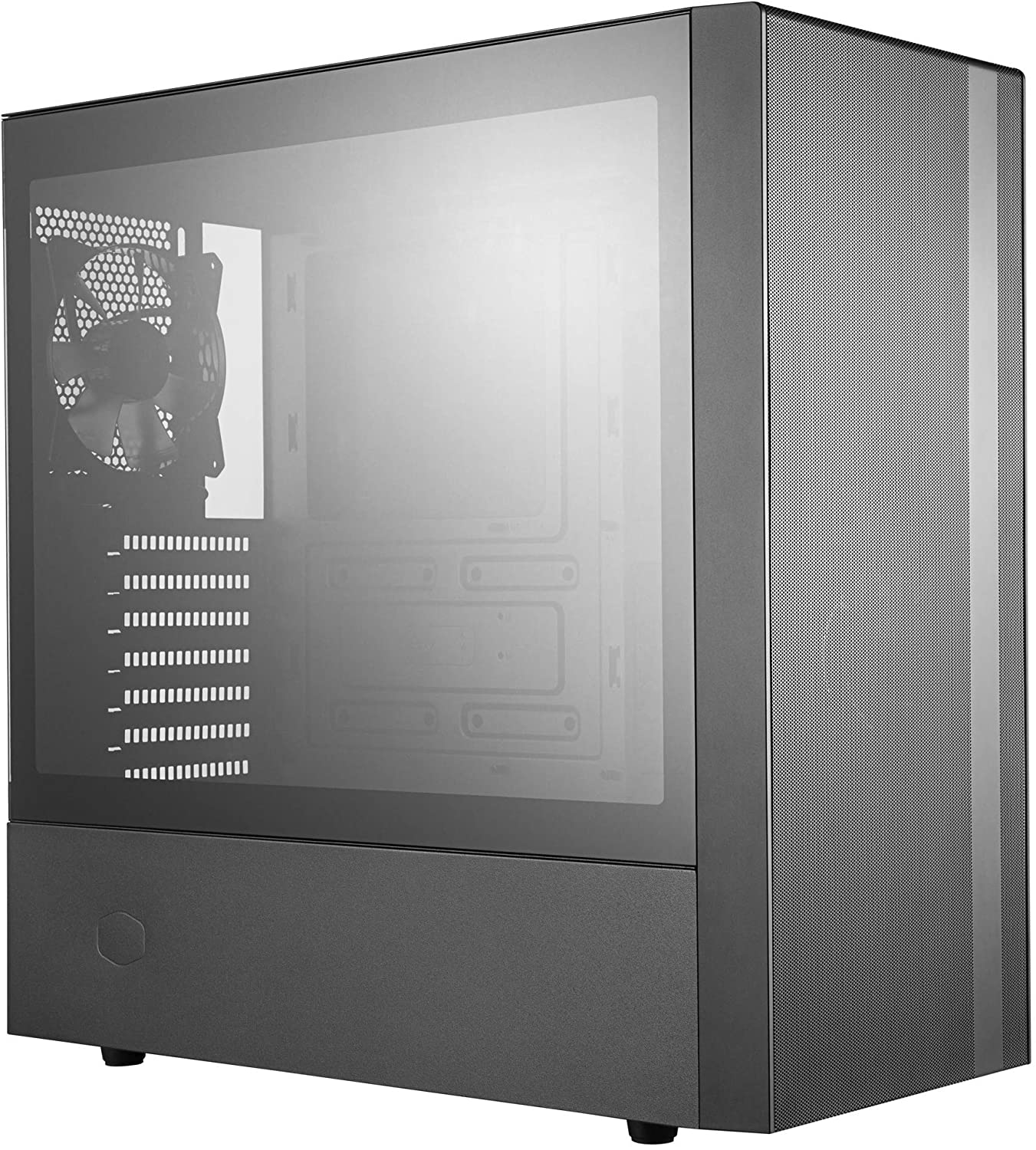
The case does not have compatibility with ATX motherboards which is a little surprising, considering that it is virtually the same size as an NZXT H510. CoolerMaster made the unfortunate decision to not include any fans in this case, which is another poor decision. Yet, this decision may be justified given the pricing range of this case.
Be sure to check out our selection of the best micro ATX cases as well for more compact options.
The NR600 is a chassis with an emphasis on airflow, and it is obvious from looking at the case. In addition to having big ventilation holes towards the back of the case and at the top of the case, it also includes a complete mesh front panel that enables the highest amount of air to travel through.
If you are interested in purchasing this case, the most prudent thing for you to do is shell out the additional money for a three-pack of standard, non-RGB fans designed specifically for cases with effective airflow. Given that the case itself is very value-oriented, grabbing a pack of high CFM fans may be the best approach.
If we can disregard the fact that the NR600 has a mesh front panel, the NR600’s design is pretty similar to that of the iconic NZXT H510 in terms of its overall appearance. The design of the power supply shroud and the contours of the side panel made of tempered glass are very similar to those of the H510.
If you purchase the ODD version, which supports an optical disc drive, the chassis has a decent appearance, but one would not describe it as classically beautiful. This is especially true if you consider the fact that it supports an optical disc drive. The cable management area is also enough, and a number of rubber grommets are given to ensure that the front view is uncluttered and uncluttered-looking.
If you are searching for a PC case that is simple in design and has excellent airflow for an affordable price, the NR600 is another excellent choice you should consider. On the other hand, in order to take full benefit of the mesh front panel, it is recommended that the case be purchased together with some fans.
All in all, it is our pick for the best micro ATX airflow PC case out there.
6. Fractal Design Focus G
Best Value Airflow PC Case
Pros
- Front Mesh Panel
- 2 Included Fans
- Affordable
Cons
- Acrylic Side Panel
- Included Fans have only White LEDs
Form Factor: Mid-Tower | Front Material: Mesh Panel | Side Material: Acrylic | Included Fans: 2x 120mm White LED Fans | Motherboard Support: ATX, Micro-ATX, mini-ITX
Considering that it can typically be found advertised for anywhere around $60, the Fractal Design Focus G is one of the most budget-friendly options that we have included in our roundup. The Focus G is a better deal than the NR600 due to the fact that it already comes with two 120mm fans that have been put in the front of the case.
This is despite the fact that the NR600 is also a case that costs in the same ballpark. Having said that, the Focus G does have a few weak spots in its design that need to be addressed.
Another option for those looking for a mid-tower chassis, the Focus G offers compatibility for ATX, micro ATX, and mini-ITX case motherboards. At this price point, compatibility for ATX motherboards is a welcome addition, considering the majority of cases in this price range only support the smaller form factors.
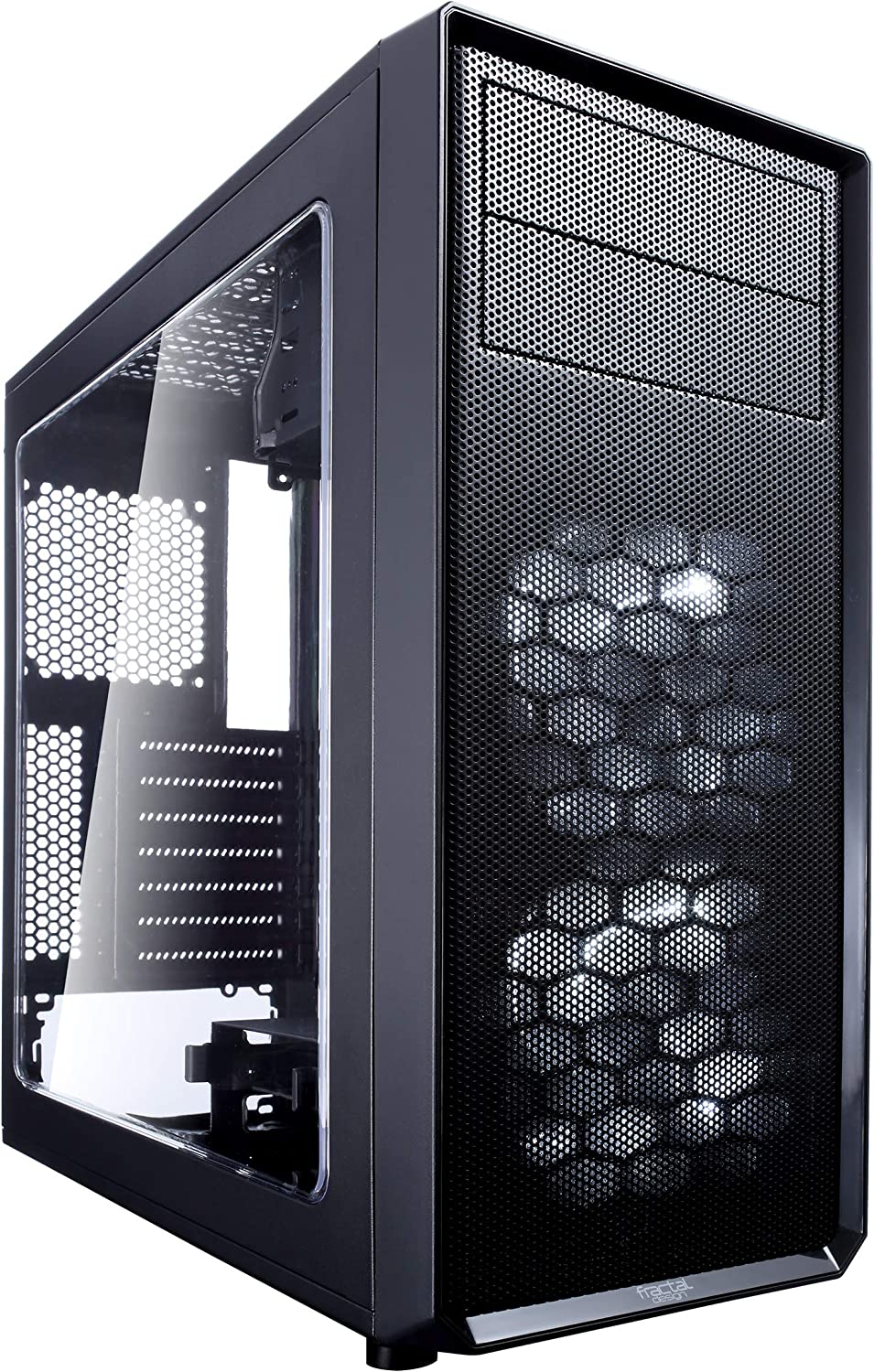
There are two 120mm white LED fans that have been pre-installed; however, because of their fixed white illumination, they may not be suitable for the aesthetic of every installation. The front of the case is made up of a mesh panel in its whole, which is a beautiful touch; however, the side of the case has an acrylic panel, which is not the ideal material for making a transparent window.
The presence of the acrylic panel is a negative since, in general, acrylic feels and looks inferior to glass. Moreover, the material also has a dreadful tendency to scratch very readily. This makes the addition of the acrylic panel a letdown. Despite this, the choice is rational given the modest cost of the case and the exceptional value proposition it offers.
As was just said, the presence of a mesh front panel is a fantastic feature that is included with this product. This is, in fact, the shining star of the whole case. We often see cases that cost 10 times this one but they do not include a mesh front panel and have worse thermals as a result. The inside construction of the casing is of high quality on the whole, and there is sufficient room for cable management.
It’s no secret that Fractal Design is an incredible PC case company that’s responsible for producing some truly remarkable cases, and the Focus G is without a doubt one of those products. This is the best value airflow PC case on the market purely due to its superb bang for the buck and should be considered if you are on a reasonably limited budget for a case.
It is an ideal case for those who do not want to compromise on airflow and thermals despite being on a relatively modest budget.
7. CoolerMaster MasterBox Q500L
Best Budget Airflow PC Case
Form Factor: Mid-Tower | Front Material: Steel with Perforations | Side Material: Acrylic | Included Fans: None | Motherboard Support: ATX, Micro-ATX, mini-ITX
The MasterBox Q500L is yet another odd product that can be obtained from CoolerMaster. It is an inexpensive computer chassis with a price point of around $50 in mind. The Q500L is a mid-tower chassis that offers compatibility for ATX, micro ATX, and mini-ITX motherboards within a case that is quite compact in comparison to other mid-tower cases.
It has a front steel panel that is perforated numerous times and is protected by a dust filter; this configuration is designed to allow for somewhat more airflow than a solid steel panel would. The side panel, like the one on the previously described Focus G, is made of acrylic. On the other hand, in contrast to the Focus G, the Q500L does not come with any fans of its own.
The interior configuration of the Q500L is likewise fairly distinctive in its own right. Due to the limited space available, CoolerMaster built it in such a way that the power supply is positioned at the very front of the case in a vertical orientation, and the motherboard is positioned such that it goes all the way from the very top to the very bottom of the chassis. The bracket for the power supply unit (PSU) may also be moved to provide additional mounting possibilities.
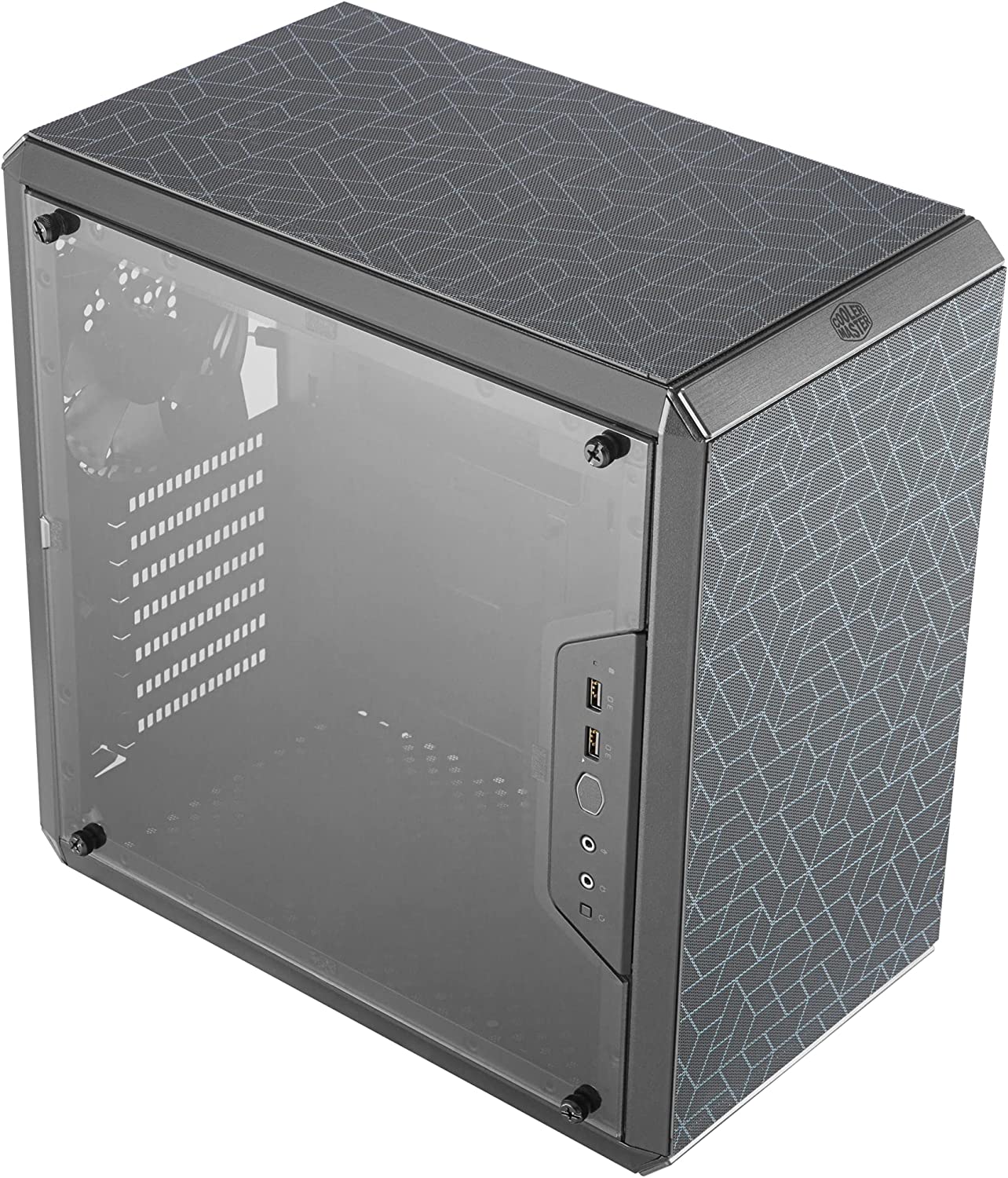
Having said that, the inside space is already very congested, so putting together a workstation in the Q500L might not be the most pleasurable experience.
Despite having a perforated front panel, the Q500L does not have the most ideal airflow in its standard configuration. However, no other case in this price bracket even offers a similar front panel. If you want to make a little bit of an improvement to the airflow problem, you might consider purchasing this case together with a set of fans to install. After you install a couple of fans, the thermals immediately improve.
It should not come as a surprise that the build quality of the casing is not the finest given that it is sold at such an extremely low price. Nevertheless, the Q500L is a one-of-a-kind, relatively compact case at a price that is extremely reasonable. Additionally, it is a case that contains the majority of the features that one can fairly anticipate finding in a case of this price range.
Speaking of budget options, you can check out our selection of the best budget PC cases for more alternatives as well.
Overall, the Q500L is a stripped-down version of the options that are mentioned above it in our case roundup. It makes a lot of compromises, but the price point that it targets is extremely competitive and you won’t find a similar design in that range anyway. We consider the Q500L as the best budget airflow PC case on the market after a few fans are installed in it.
How we picked and tested
Airflow is a surprisingly undervalued feature in the current PC case market as the majority of cases out there prioritize other aspects of the case over airflow. Most manufacturers traded airflow and thermal performance for aesthetics and RGB lighting, which is a poor tradeoff all things considered.
In light of this, we were careful to establish strict criteria for the selection of the cases included in this overview.
The size of the PC cases in question was a matter of priority for us. The quality of airflow tends to scale linearly with the size of the PC case, and more space for future growth is always welcome. Therefore, we focused on mid-tower and full-tower variants for this roundup.
Second, we picked out casings that worked best with available PC hardware in terms of compatibility. We especially focused on cases that made it easier to upgrade the cooling potential of the system by accommodating additional fans and radiators, etc. Extra water cooling features provided by cases were also taken into account while rating them.
While compiling this list, we paid close attention to how each case looked aesthetically, as well. The case has a significant role in determining the aesthetic value of any PC build in a particular setup. So, the cases’ style and illumination were thoughtfully explored.
We also paid close attention to the many intangibles associated with quality of life that might ultimately decide a case. We took into account a variety of criteria, including, but not limited to, the case’s weight and overall quality of construction.
The value and cost of each case that we selected were also taken into account. Though most cases with superior airflow tend to be a bit pricey, we gave preference to those that provided the best value for money.
Our professional hardware testing team did not spare any effort in ensuring the highest standards of testing. Each contender was thoroughly examined by subjecting it to a series of tests developed to gauge its thermal and airflow efficiency.
Since the airflow of the casing is utilized to cool the radiators, thermal testing is essential for water cooling systems as well. Our ability to compile this overview was considerably aided by the empirical and objective data we gathered from these examinations.
This provided the editorial staff with valuable insight into the build quality and thermal performance of the variety of cases in our roundup.
We have compiled a list of the best airflow PC cases on the market by combining the results of our tests with an impartial examination of the cases’ features and costs.
Airflow Optimization Guide
When building your own PC, one of the most important things you should do is work on improving the circulation of air within the computer’s chassis. This approach should not just be tried by enthusiasts, but also by regular users on a more casual basis. This can keep the components of your computer from overheating, prevent the chassis from suffering exponential dust buildup, and, in general, improve the components’ expected lifespan.
In the first step, we are going to work on building up positive pressure inside the chassis. When we talk about positive airflow, what we mean is that the fans located inside of your system are taking in more fresh air than they are pushing out of the system in the form of hot air. Due to this, a positive cooling cycle is produced, which is exactly what you want to achieve.
When there is more air being flushed out than there is being drawn in, negative air pressure develops. This creates a potential vacuum that may start sucking air from cracks and crevices in the chassis, which results in an enormous amount of dust accumulation. The intake and expulsion cycles are balanced in a system with equal air pressure.
Moreover, placing the system in a cooler environment will allow for cooler air to be pulled in, which will reduce the temperatures of both your CPU and your graphics card (GPU). Fans, which are the primary operators in this entire cycle, have the potential to be the ultimate game-changers in successfully circulating the air depending on their size, speed, alignment, and type.
Radiators, if placed appropriately, may function as effective exhausts. In addition to ensuring that your system cools properly and that its circulation is not disrupted by unwanted foreign bodies, keeping your system clean on a regular basis and taking preventative efforts to keep dust and other particles that might cause blockages out of your setup are two of the most important things you can do.
Last but not least, if your chassis is still becoming too hot, you should consider looking at our recommendations for the best airflow PC case alternatives currently available and replacing it if necessary. It’s possible that our in-depth PC case buying guide will come in handy here.
Buyer’s Guide
The PC case market is flooded with dozens of cases that are utterly useless in terms of their functionality and have absolutely terrible airflow. These cases often prioritize aesthetics and RGB lighting over airflow, which is a poor deal in exchange for the health of your components.
This is why our specialized team of hardware experts has curated a comprehensive PC case buying guide. These factors should be considered carefully when shopping for a PC case, lest you end up regretting your choice.
Case Size
When it comes to cases that are optimized for airflow, the amount of available space is of the highest importance. The fans and other cooling components will make up the cooling system, and these components need to be kept at a reasonable distance from the motherboard and allowed sufficient room to breathe in order to function properly.
Even if you are capable of accommodating all of your components within the case, the case itself needs to be able to assure that all of the components are maintained at temperatures that are ideal for them or that are as cold as is reasonably feasible. This may be difficult to achieve in cases that are of a smaller size, but it gets much simpler to do so in larger cases.
This means that full tower cases are a far better solution if you want the best airflow as compared to other types of cases. While it is possible to get away with a mid-tower chassis, the quality of airflow generally decreases as the case gets smaller. This means that mini ITX cases generally suffer a lot in terms of airflow due to their compact size.
The increased space will also be crucial since it will enable you to set up any additional cooling accessories that are necessary to cool certain components, such as water cooling loops. Having this space in a bigger case will allow you to cool specific components more effectively.
Compatibility
When deciding which computer case to buy, compatibility should be at the top of your list of priorities. In spite of the fact that the majority of the available cases are very versatile in their compatibility, you still need to be sure that the components you choose are compatible with the case you want to use.
Be sure to verify specifically that the selected case can handle your motherboard and provides a proper amount of clearance for the various components of your computer, such as the power supply and the graphics cards. The length of the graphics card is an especially important consideration to make.
The case should be large enough to accommodate all of the components of your cooling system, have adequate room to neatly arrange all of the cable connections, and have an airflow layout that is generally effective.
Additionally, expansion slots and modular brackets are both fantastic additions to any PC case, but it is not required to have either one of these features. Your major concern should be finding fans and other components that are compatible with the radiator sizes that you want to install. Compatibility of the case with those radiator sizes should also be a consideration.
If you want to save yourself trouble in the future, it is in your best interest to double-check that all of your components are compatible with your selected case.
Airflow and Ventilation
It is possible to recognize a good PC case by the fact that it has sufficient airflow in proportion to its size and variety of the components that it can house. Moreover, it is a good idea to have a case that is readily optimized for airflow from the manufacturer, so that you don’t have to tinker much with it. The simple installation of more fans is not necessarily going to solve the problem of poor airflow design.
As a result, your first choice should be to choose a case that has been made in such a way that it not only offers adequate space for optimal airflow but also is designed to improve upon that aspect of the case’s performance.
Due to the fact that there is a multitude of PC cases now available on the market, you have access to a broad array of alternatives to choose from. These choices range from certain implementations that are too enthusiastic to others that are plain but incredibly effective.
Be sure to look for front panels that are unrestricted, preferably employing a mesh material with large holes. Nowadays, case manufacturers are innovating in this regard, and we have seen some unique front panel designs that allow for a lot of air to be drawn in without any compromise to aesthetics.
Therefore, when choosing a case for your computer, make sure to check for options that include dust filtering and mesh panels. Even if you want to use water cooling for your components, having sufficient airflow is essential since it is necessary to cool down the radiators in addition to the graphics card and other components.
With the assistance of our in-depth guide that details how to optimize your case’s airflow, it won’t be difficult for you to keep the airflow conditions in your PC case at the ideal level.
Aesthetics
If you are the owner of a custom PC and you want to display your rig in all of its splendor, the aesthetics of your machine are quite important. It is not at all crucial in terms of functionality; yet, there is a certain assurance and sense of satisfaction that comes with having a well-designed computer.
This particular subject also encompasses a large number of unique points of view, which means that even if there is a case that you really appreciate, there is still a good probability that there is someone else there who does not prefer it. It makes no difference if you like stealthy black cases or all-white builds with loads of RGB lighting because it all comes down to a question of personal preference.
Not only does the layout of the computer case have an influence on its proportions, but it also has an impact on the number of cables and components that can be contained inside of it. Therefore, there is still a functional element to design at the end of the day.
Before you make a final decision on your purchase, however, you should give some thought to the style and appearance of the computer case you intend to buy.
Best Airflow PC Case - FAQs
The number of fans that you need to install depends entirely on your budget and preference. In a case with 6 fan options, it would be ideal to install two intake fans and one exhaust fan. After a certain point, the benefit is not worth the added cost.
Positive pressure is better than negative pressure in a PC case because it reduces dust buildup and improves the temperatures of components such as the CPU and GPU. You can establish positive pressure by installing more intake fans than exhaust fans.
Fan speed or fan RPM does have an impact on performance and acoustics, but not to an extent that it should worry the average consumer. If the number of intake fans in your case is the same as the number of exhaust fans, then the fan RPM dictates the pressure of your case, whether it is positive or negative
You can improve airflow in a PC case by installing more fans, especially on the intake side. You can also install bigger and faster fans that can move more air, or you can modify the front panel if you are comfortable with modifications.
Generally, the mesh type of PC cases have better airflow than those that have tempered glass on the front panel. Mesh panels offer less resistance to the incoming air, which is why it is easier for the intake fans to draw in more air and cool down the components.
 Check Price
Check Price




